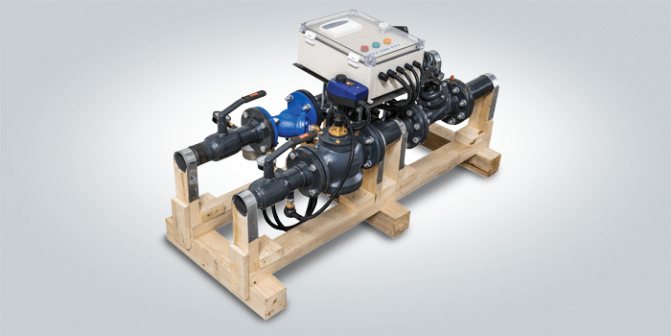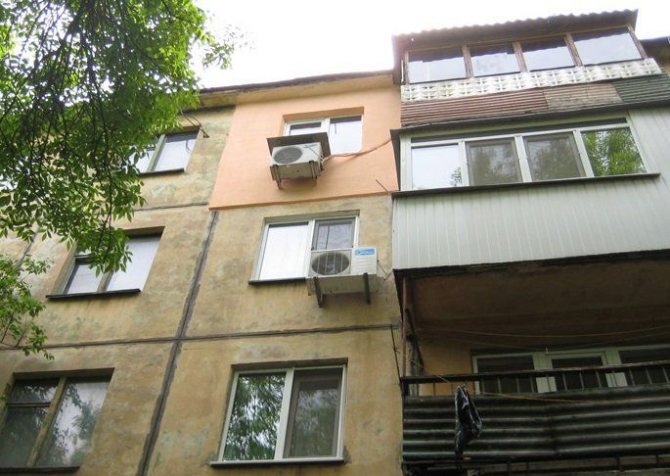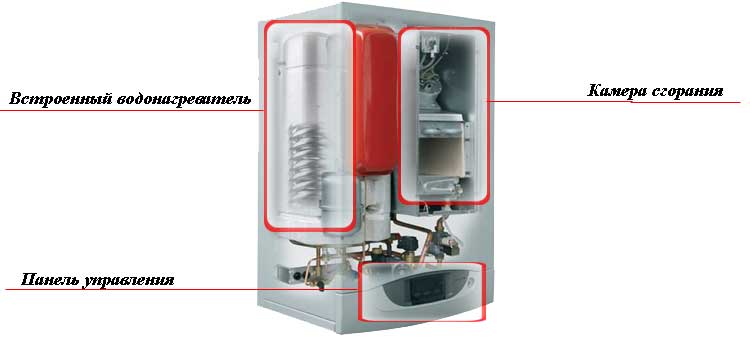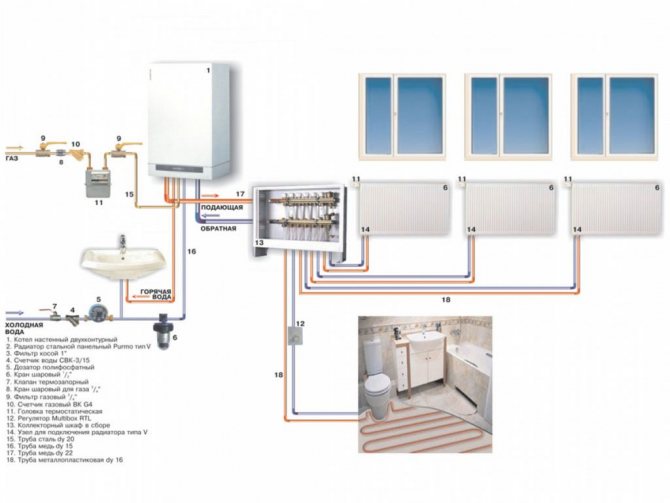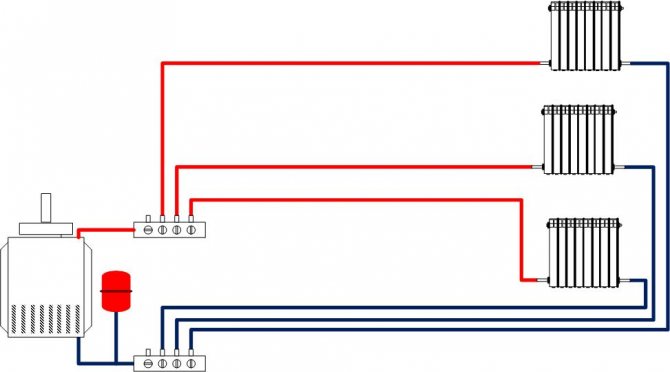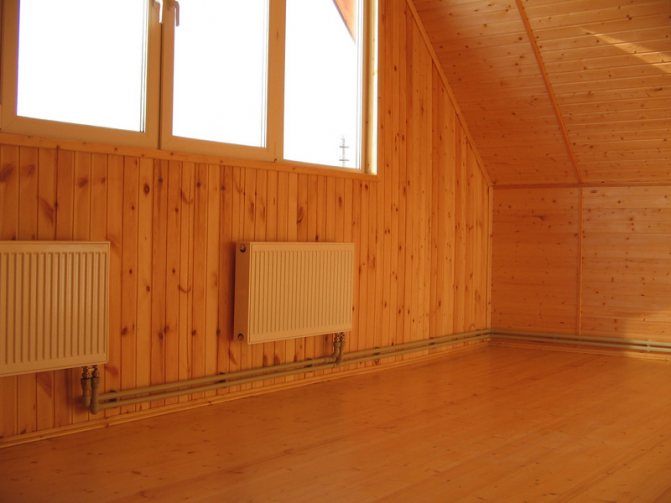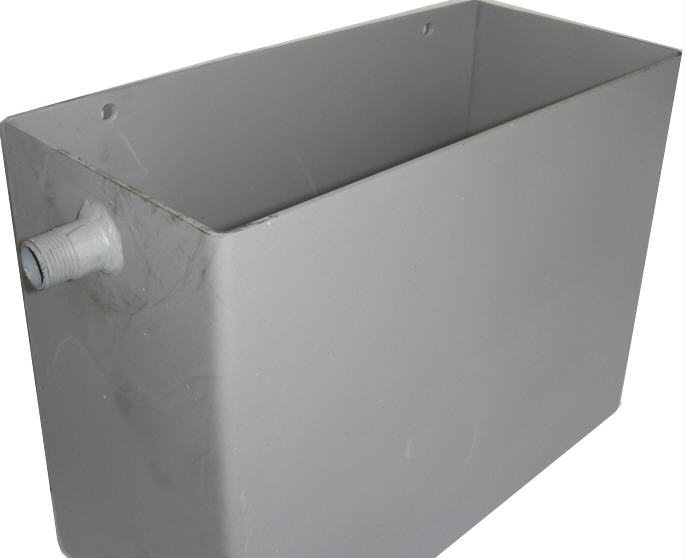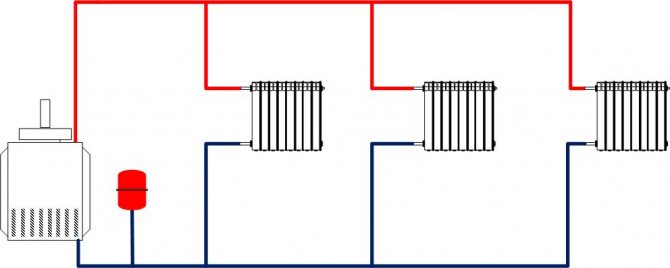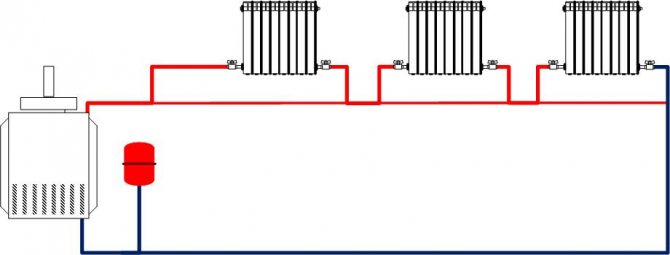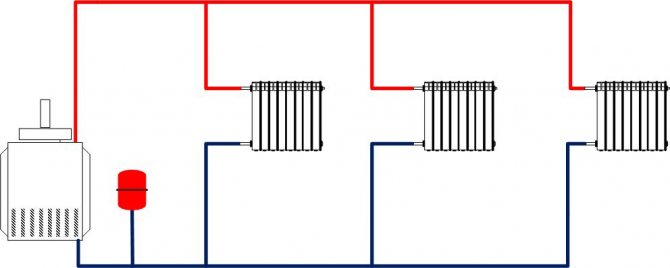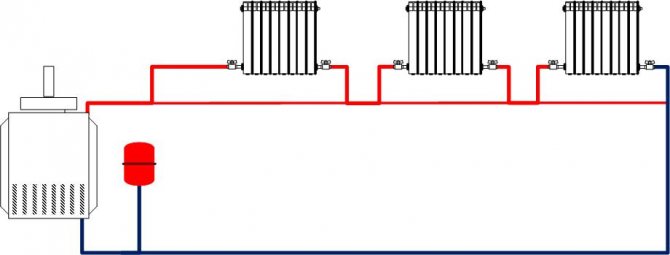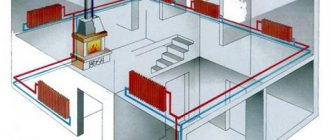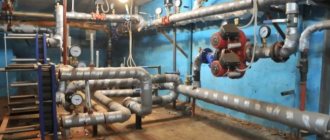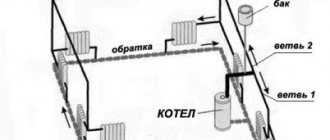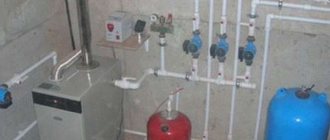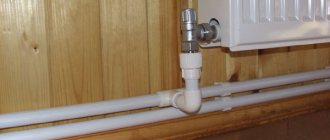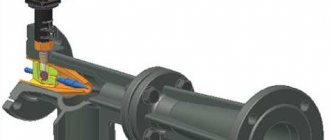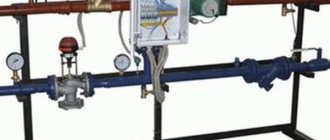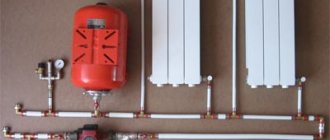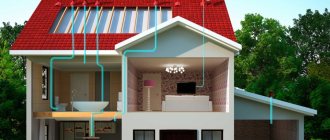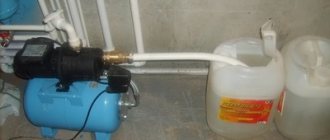Hot water supply in heating systems
Residents of Khrushchev can solve the problem of inefficient heating by installing modern radiators and pipelines in the apartment. To understand how to choose the right heating batteries for an apartment, it is important to study the performance characteristics of heating devices made of different metals. It is most rational to replace heating devices in all apartments connected to the same riser.
Single-pipe heating systems for apartment buildings, due to their economy, have many disadvantages, and the main one is a large heat loss along the way.
The heating device in a nine-story building is made according to a completely different principle. The supply line, bypassing the apartments, is immediately carried out to the upper technical floor. An expansion tank, an air relief valve and a valve system are also based here, which allows you to cut off the entire riser if necessary. In particular, the temperature in winter will be at the level of 20-22 degrees, and the relative humidity will be about 40%. To achieve such indicators, not only the basic heating scheme is important, but also the high-quality insulation of apartments, which prevents heat from escaping to the street through cracks in the walls, roof and window openings.
This is one of the best mechanisms for raising the temperature in an apartment. It can be installed not only in the bathroom and kitchen, but also in living quarters. It is best to choose infrared floor heating models, since their installation requires a minimum increase in the thickness of the floor covering. The heating circuit of the Khrushchev is not designed for connecting a water-heated floor.
But in order for the efficiency of central heating to be at the proper level, the heating scheme in an apartment building is drawn up by professionals in their field - heating engineers. The fundamental principles by which a house heating scheme is designed are to achieve maximum heating efficiency with a minimum waste of resources.
And it is especially noticeable on reinforced concrete floors. On the lower side of the floor there is a residential apartment, and on the other side of the floor there is outdoor cold. Can you imagine what a huge heat flux passes through the wet ceiling over the entire living area if the ceiling is not well insulated?
The lion's share of the modern housing stock in large cities falls on multi-storey buildings built during the Soviet Union. In those days, the issue of saving heat was not so acute, and residential buildings were heated through a centralized system.
Installing bimetallic heating radiators with your own hands.
Even before installing heating radiators in an apartment with your own hands, you need to decide on the installation parameters. To install a radiator operating only on the convection principle, the following technological distances are required:
- from the floor to the radiator 10-15 cm. - providing a gap for air flow.
- similarly, from the radiator to the window sill 10-15 cm. - Providing a gap for air outflow.
- the distance from the rear side to the wall is 3-5 cm, excluding the thermal insulation installed on the wall prior to installation.
As mentioned earlier, bimetallic radiators will be installed (Italy). Before we are going to connect the heating radiators to the general network, it is necessary to drain the coolant from the central heating system. This operation in my case was closed by the execution of an agreement with the housing office for a certain date and payment of the receipt.
An employee of the housing office who appeared in the morning said that everything was ready and that you could start.
First of all, we carry out the installation of the battery body kit. For this we need 3 pass-through plugs for connecting two input American women and one for installation on the upper left side of the Mayevsky crane, which will help bleed air when the system is started. In the lower left part, we will simply install a plug. A very important point, as for me, to use only tow and paste for threaded connections and not in any case fum tape, which I consider to be the weakest link when using. After the body kit of the heating battery (bimetallic) is assembled, we begin the actual work on the riser. As you can see in the photo below, we start the work by cutting off the cast-iron battery itself with a grinder (cuts 1 and 3), remove it and start cutting the riser at point 2. Now we take two pipe wrenches, one of which we hold the pipe going to the neighbor from the top and unscrew the other that part of the pipe we do not need, on which the old (not working crane) is located. Then it's all a matter of technology, we cut the threads at the cuts 2,3 points with the help of a scraper and assemble a structure from a tee, extension cords and ball valves, two of which are with an American (seen on the right side of the photo below). After we have everything assembled, we attach a bimetallic heating radiator and lightly bait the American women by installing it, for example, on books or any other support when using a building level. Now we can mark the mounting points of the radiator on the wall. We remove the radiator and, at the designated points, make holes for the dowels with a puncher, where we then screw in a standard 170 mm bracket. The distance from the wall can be adjusted by twisting / unscrewing the bracket. Additionally, you can use screens for heating radiators that are mounted on the wall before installing the battery and reflect the heat back into the room, preventing the wall from heating.
Yes, until I forgot, the entrances to the heating battery have their own distance between the axes, which in my case is 50 cm.So, when assembling a heating system with a bypass and outgoing taps, this parameter must be taken into account, and the distance between the axes of American women will likewise be equal to 50 cm.
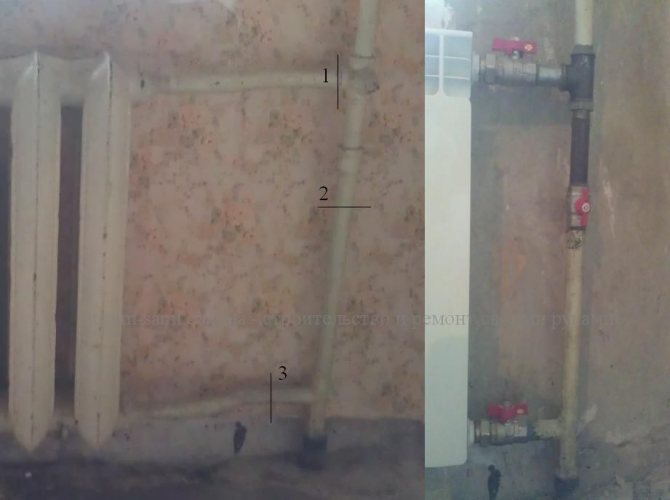
This completes the installation of heating batteries in the apartment and requires only cleaning the heating pipes and subsequent painting. What happened in the end can be seen in the photo below.
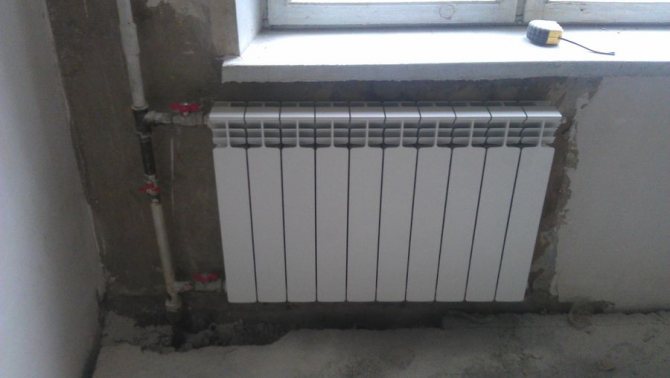

Calculation of radiator sections. Heat dissipation of radiators.
Before performing calculations, you must be sure that the other factors affecting heat conservation, such as external insulation, replacement with new windows and slopes, are fulfilled.
To calculate the heating radiator sections, we need the initial data:
- power of one radiator section (heat transfer from radiators).
- area of the heated room.
- the required heat output per square meter of the room.
For my case (sectional radiators), the power of one radiator section (heat transfer of radiators) is 180 W and the area of the heated room is 15 square meters. According to SNiP, 100 W of thermal power is required for one square meter of the room. We get the formula:
Number of radiator sections = 15 (room area) x 100/180 (section heat transfer)
We get the value of the number of radiator sections equal to 8.3. We round this value up and get the value 9, and given the fact that manufacturers actually slightly overestimate the value of the section's power, I decided to add another one. Thus, for my rooms, the value of the number of heating radiator sections came out equal to 10. When calculating the radiator sections, I did not take into account the fact that a warm floor would be made in the kitchen, since it was not made for heating, but for a comfortable temperature.
After the poured floors had dried and the radiators had been replaced, I was able to start laying the laminate in the rooms.
Centralized heating scheme for Khrushchev
The installation of new heating devices on all floors will result in a round sum, but such measures will give tangible results instantly.
Repair work with heating with water draining even from one riser in cold weather is very fraught with scandals with neighbors and even the formation of not only air, but also ice jams in the heating system in the basement and entrance.
Materials with a large dependence of thermal insulation properties on absolute humidity include: concrete, cement screeds, expanded clay, red brick, sand-lime brick, wood, foam concrete, various gypsum-cement-sawdust-slag materials - almost everything that is not foam and polyurethane foams closed cell.
But when the pressure exceeds the norm, it is simply dumped into the expansion tank, and when the coolant cools, as a result of the column pressure, it returns back to the circuit. Such containers in private houses, as a rule, are installed in the attic.
Consider the option with a heating film
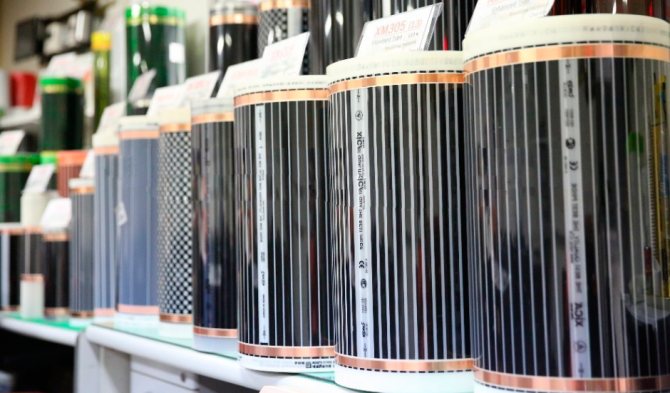

This is one of the progressive types of heating with the technology of heating elements of an infrared polymer film (and from it, in turn, the floor) using electricity. The thickness of such a film made of polyurethane or polyurethane with conductive strips, laid in a certain order, is minimal - only 0.2-0.4 mm.
Even when installed with a layer of thermal insulation (about 3 mm) and a thin plastic mesh, this will practically not affect the decrease in the height of the rooms.
Thermal insulation is needed so that you do not heat the neighbors on the floor below, and the plastic mesh protects the heating film from damage, and also makes it easier to install the tiles.
Please note - heating from IR film does not require cement screed and is laid directly under the floor covering.
As a rule, the film is delivered in the form of a roll of a predetermined length, while the step of the cutting line is indicated (for example, 18 or 25 cm). Another configuration option is ready-made sections of a certain length, width and capacity, which are easily connected to each other. Therefore, installation is easy even for a non-professional. I recommend looking at all the options and characteristics of the films here).
Types of connections to heating systems
The main function of the unit is to directly participate in the heat exchange process, since the hot coolant, getting into it, is dosed and mixed with the injected coolant from the return. As a result, the unit allows you to achieve optimal results in matters of mixing the hot coolant from the boiler room and cooled water from the return.
This can lead to a decrease in pressure in the pipes and significant heat loss for residents below. In order to avoid unpleasant moments, you can perform a number of actions that contribute to energy saving in the apartment.
The main thing is that the house does not keep warm if the inside of the apartments is damp. About plastic windows. How much does central heating cost if a damp, cold apartment is a heat meter?
The negative point is that the heating scheme of the five-story Khrushchev house does not provide for the connection of additional radiators.
The radiator batteries are installed in series, without a "main" riser - see the heating diagram below - this is the case.
The implementation of such modernization can be carried out not only by the forces of residents, but also by attracting the resources of the housing office. This organization is obliged to carry out a planned replacement of pipelines. They also know how the heating system is arranged in Khrushchev - the layout and location of pipelines for a particular house.
First, let's pay attention to the local or autonomous heating system, used mostly in the private sector and in rare cases (as an exception) in multi-storey buildings.In such cases, the boiler room is located directly in the building itself or near it, which allows correct adjustment of the coolant temperature.
In addition to the boiler, the existing circuit will have to be re-equipped. Heating batteries used and new radiators can be connected to it, which are tied with a pipeline in accordance with the heating scheme. Depending on the required heat output, low radiators installed under the windowsill, as well as standard radiators, can be used in the heating circuit.
Important: some residents of the outer floors are trying to move the air relief valve to the attic, so as not to collide with housing and communal services workers every season.
This is due to the alternate passage of the coolant through the floors, i.e. the greatest degree of its heating will be at the 5th, 4th, and at the 1st, the amount of heat is not enough to heat the room. In addition, the heating scheme of the five-story Khrushchev has the following disadvantages:
- Poor condition of heating elements. Lime build-up on the inner surface of pipes and batteries leads to a decrease in diameter, and as a result, a decrease in heat transfer;
- Lack of temperature control system on batteries. It is impossible to reduce the flow of coolant with devices, as this will affect the hydraulic pressure in the entire system. Output - installation of a bypass for each radiator.
Tips for Minimizing Heating Costs
In addition to the modernization of the autonomous heating installation, a number of actions can be performed, the result of which will lead to a decrease in the current operating costs and payment for housing and communal services. Given the specific layout of the heating system in Khrushchev, the installation of heat meters in an apartment is impractical. This is due to the absence of a central riser, i.e. even for a one-room apartment, you will have to install at least three meters - in the bathroom, in the kitchen and in the living room.
The total cost of installing one device can range from 25 to 30 thousand rubles. The way out of this situation is to install a common house meter. It will take into account the amount of heat consumed for the entire building. Fortunately, the centralized scheme inherent in all types of heating Khrushchev allows you to do this. As an additional function, a mode for adjusting the heating agent supply depending on the outside temperature can be provided.
For the central heating circuit of a five-story Khrushchev, a balancing riser can be installed. It will perform the functions of evenly distributing the coolant over all floors of the house. However, which project is carried out only by agreement with the housing office, since it belongs to the category of changing the principle of hot water supply.
If old steel pipes and radiators are installed in the house, it is recommended to carry out periodic chemical and mechanical cleaning. Before that, the socialists must carefully study the heating scheme of the five-story Khrushchev house in order to draw up a work plan. It is recommended to clean up the apartments on the upper floors. As a result, the permeability of the coolant through pipes and radiators will improve.
Some schemes of heating systems in Khrushchev and their design provided for hidden installation of radiators. This installation method is effective only if the outer walls are insulated.
As an alternative type of heating, you can see the video on installing electric heating elements in radiators.
Autonomous heating is good for those who have it. But the rest of the tenants pay for the heating of common areas of use and common risers pass through apartments with autonomous heating and heat them. Therefore, they do not include heating in the autumn and spring months. In addition, the entire box of the house is heated from the general heating. the cost of heating for an autonomous one is 10 times less. Theft of heat, permitted from above, takes place.
In recent months, heating costs (at a rate of 1621.95) 1829.34-November 16, 2414.69-December 16, 2656.10-January 17, 2895.22-February 17 Why? Is there any kind of individual heating in the house at 11, Polyustrovsky prospect? During this period, there was no heating at all for several days due to accidents. An example of another adjacent house: (norm-1621.95) 634.41-November 16, 1305.33-December 16, 1224.12-January 17, 1207.1-February 17. The truth is that they treat people in good faith and recount all losses, hold conversations with non-payers, sue, withdraw money from non-payers' compensation, and do not throw debts on bona fide tenants.
Features of heating an apartment in a multi-storey building
The implementation of such modernization can be carried out not only by the forces of residents, but also by attracting the resources of the housing office. This organization is obliged to carry out a planned replacement of pipelines. They also know how the heating system in Khrushchev works - the diagram and location of pipelines for a particular house.
Pipes above windows or under the ceiling spoil the appearance of the premises. In addition, some of the heat is lost through the ceiling. Therefore, there is a scheme with a supply pipe under the radiators.
For such a circuit to function properly, the expansion tank must be above the horizontal coolant supply pipe in order to create columnar pressure. That is, hot water from the boiler enters the circuit during expansion.
When air pockets form in these places, the pipes are subject to corrosion, since the natural pressure is not able to push the air.
How, traditionally, heat is supplied to our apartments
Previously, to connect the internal heating systems of buildings to the centralized heating network, the so-called elevator units were used, the main and, sometimes, the only component of which was a water-jet elevator. This device was designed to mix the chilled water coming after the heating system to the high-temperature heat carrier from the heating network in order to reduce its parameters to a level acceptable for use in the internal heating system and ensure its circulation.
However, at present, such units not only do not meet modern energy efficiency requirements, but are also prohibited for use by the current state regulations, and therefore must be replaced.
Heat supply of a multi-storey building
What to do if, even after performing the improvement and replacing the elements, the temperature in the apartment is far from ideal. The best option is autonomous heating in Khrushchev. However, this is not always possible - the installation of a gas boiler is not allowed due to low pressure in the line or due to inappropriate chimney ducts.
In order to understand how much heat carrier you use to heat a house with a large number of apartments, the best option would be to install a house meter. To calculate the payment for the consumed heat, readings are taken from the meter. They are divided by the number of apartments in the house and by their area.
A well-designed heating system for an apartment building, a scheme for which is developed individually, guarantees that optimal conditions will be maintained inside the apartments.
Special attention should be paid to windows in apartments and balconies. It is recommended to install meters in each apartment and install taps to regulate the temperature of the consumed energy carrier.
Additional measures
Even after new radiators have been installed for an apartment, prices for which depend on their type, residents of Khrushchev may note the insufficient efficiency of central heating.
Autonomous heating in Khrushchev
In order to radically solve the problem of cold batteries and low air temperatures in Khrushchev, the apartment owner can implement an autonomous heating project.The project provides for the installation of a separate boiler in the apartment and the presence of a well-developed project that regulates the technical conditions according to which the autonomous heating system will operate.
The boiler for Khrushchev is selected in accordance with the area of the apartment.
Often, a 7-8 kW device is enough to heat a two-room apartment with an area of sixty square meters. According to the regulations, the boiler must have a closed combustion chamber, be equipped with a coaxial chimney and be installed in accordance with the recommendations specified by the manufacturer.
Re-equipment of the circuit
In addition to the boiler, the existing circuit will have to be re-equipped. Heating batteries used and new radiators can be connected to it, which are tied with a pipeline in accordance with the heating scheme. Depending on the required heat output, low radiators installed under the windowsill, as well as standard radiators, can be used in the heating circuit.
Sources of
- https://StrojDvor.ru/otoplenie/otoplenie-v-kvartire/standartnaya-sxema-sistemy-otopleniya-xrushhevki-i-eyo-ustrojstvo-vozmozhnost-modernizacii-i-ustanovki-avtonomnyx-kompleksov/
- https://gidroguru.com/otoplenie/operacii/proektirovaniye/1544-shema-sistemy-otopleniya
- https://teplo-ltd.ru/otoplenie/vnutristennoe-otoplenie-v-hrucshevke-shema.html
- https://SpetsOtoplenie.ru/otoplenie-mnogokvartirnyh-domov/problemy-otopitelnyh-sistem-i-ih-ustranenie/kak-ustroena-sistema-otopleniya-v-hrushhevke.html
[collapse]
Heating system in Khrushchev: diagrams, heating device for a five-story building
In residential buildings, for a comfortable stay, high-quality communications are needed, including those intended for heating. They are divided into two large groups - one-pipe and two-pipe. The former are much simpler and cheaper. Hot water is supplied and discharged through one pipeline to all heating devices connected in series to the system.
The supply is ringed on the last radiator, where it can switch to return either with the same pipe or through the battery, which practically does not make any difference - it just depends on the ease of installation.
It is no secret that losses during transportation can reach up to 30% and we have to pay for all this. Avoiding central heating in an apartment building is a tricky and troublesome process, but first, let's figure out how it works.
The essence of the operation of a two-pipe heating circuit is as follows:
- the coolant from the heater enters the supply pipe;
- where it is alternately distributed through the radiators;
- and after the liquid passes through the sections of the device, it enters the return pipe, through which it is fed back to the boiler.
Before choosing, be sure to check the capabilities of your wiring
From this point you need to start planning work in the old housing stock. More than half a century ago, the residents of Khrushchev did not have any powerful electrical appliances - no boilers, no electric kettles, no electric ovens. The wiring was carried out using an aluminum wire of a small cross-section (often 2.5 sq. Mm, less often 4 sq. Mm), the grounding system was absent as unnecessary. Ideally obtained 2.5 kW per apartment was enough for lighting and TV.
But today, before you get to work, be sure to revise the existing electrical wiring. Most likely, if it has not yet undergone major repairs, the wires will have to be replaced. As Evgeny advises, from 10 years of experience in the electrical goods trade, you need to replace aluminum with a copper cable with a cross section of 4 sq. mm. for a one-room apartment and from 6 sq. mm. for "kopeck piece" ("treshki").
If you leave the old one, then the electrical heating system, at least, will take half of the power on itself, at the most, if the network is overloaded, emergency situations will arise.
Let us illustrate with an example. In apartments built according to Khrushchev's standards, the kitchen area ranges from 5 to 7.5 square meters. m. Let's say that in the kitchen of 7 squares of usable area, 5 square meters remain. m. If you want to organize the main heating with an IR-film, the power of which, we recall, should be about 200 W / m2 for this mode, the total power of the system for the kitchen will be:
5 m2 * 200 W / m2 = 1000 W.
A whole kilowatt despite the fact that the old wiring for the entire apartment allocates 2.5 kW.Almost half of the available power is immediately consumed, but how can a modern person, surrounded by technology, live on the remaining 1.5 kW?
Features of heat supply for multi-storey buildings
Such a heating system in a five-story building or in a building with fewer or more floors allows heating at certain times of the year and paying bills for the actual energy consumption. Such a heating system for Khrushchevs implies that a meter is installed to control the heat, from which monthly readings are taken.
There are a lot of nuances that need to be observed, and there is no guarantee that local authorities will release your home from control.
The centralized heating system in Khrushchev is implemented using a single-pipe piping of radiators. According to the scheme, the coolant spreads along the contour, starting from the fifth floor. As it passes through the system, the cooled coolant enters the basement (basement).
Then they begin to develop alternative ways to increase the temperature in the room. The negative point is that the heating scheme of the five-story Khrushchev house does not provide for the connection of additional radiators. This can lead to a decrease in pressure in the pipes and significant heat loss for residents below.
Coolant circulation methods
The main thing that distinguishes the scheme of heating systems is the organization of the movement of the coolant along the heating circuit or several circuits. Allocated natural and forced circulation of fluid along the contour.
Scheme of natural circulation of the coolant
Such heating provides that the coolant will move along the circuit as a result of thermal expansion. The heat carrier, warming up in the heating boiler, rises up, because, having a lower density, it is displaced by the colder heat carrier coming from the return part.
The displaced hot coolant, after rising along the riser, moves along highways that have a slight slope of 3-5 degrees.
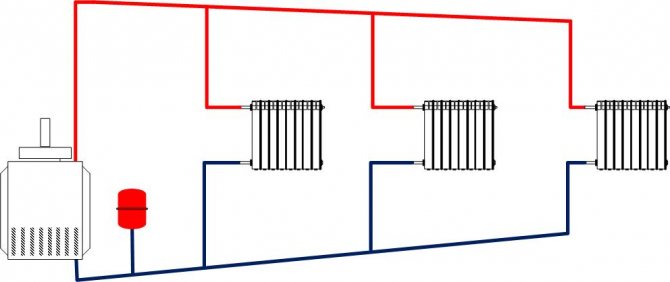

An example of a natural circulation pattern
The scheme of the heating system, in which natural circulation is implemented, is very simple to implement, it is not connected with any other communications.
Attention: This system can be used for heating small houses. It is only effective if the circuit has a total length of no more than 30 meters.
Scheme of forced circulation of the coolant
In this system, the coolant moves due to the fact that there is a pressure difference in the direct and reverse parts of the circuit. And this pressure difference is created by a specially used heating circulation pump.


Example of a forced circulation circuit
Such a scheme has no restrictions on its use, but the performance is determined by the circulation pump, its power and power supply.
Installation of a heating system in an apartment building
As the name implies, the bottom-filling distribution scheme provides for the supply of the coolant from the bottom up. The classic heating of a 5-storey building is assembled according to this principle.
Such a system works on the principle of deaeration or automatic regulation of the maintained pressure using a special, hermetically sealed expansion tank. Such a container consists of two sectors, separated by a heat-resistant rubber membrane.
The disadvantages include:
- many pipes and fittings;
- rather complicated installation;
- higher cost than a single pipe system.

